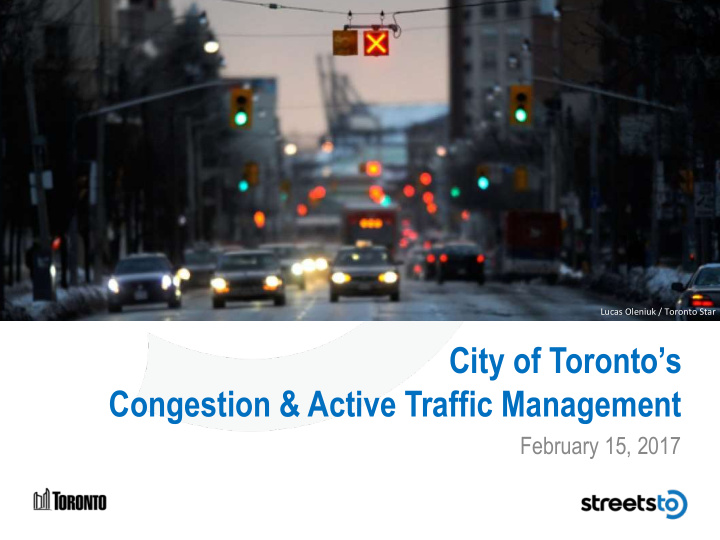



Lucas Oleniuk / Toronto Star City of Toronto’s Congestion & Active Traffic Management February 15, 2017
Congestion Management Plan (CMP) • Objectives: – Improve traffic flow – Improve safety – Improve management of traffic congestion 2
CMP Activity To-Date (2013-2016) • Upgraded Operations Centre • VMS Installations • Travel Time Deployments • Signal Coordination • Arterial CCTV Cameras • LED Blank-out Signs • UPS for Traffic Signals 3
Operations Centre Upgrade New Concept of Operations, new video wall, new ATMS, new video management, new traveller information strategy 4
17 VMS Installed on DVP & Gardiner Incident, safety & travel time messages 5
Arterial VMS Pilot Travel time and expressway incident advisories 6
148 Arterial CCTV Installed 7
14 Sites with LED Blank-out Signs 8
75 UPS Installed for Traffic Signals 9
Transit Signal Priority Strategy 10
Traveller Information Strategy 11
On-Going Work Purchase of Commercial Data (Feb) Turn Restriction Blank-Out Signs (Q3) • • Data Warehouse Plan (Q1) Arterial CCTV Cameras (Q3) • • Active Traffic Management Strategy (Q1) UAV readiness (on-going) • • • Advanced Traffic Mgt System (Q2) • ITS Risk Assessment (Q4) • Smart Work Zones (Q2) • Adaptive Traffic Signal Control (Q4) • Coordination Studies (all year) • Lower Don Flood Impact Mitigation (2018) 12
Upcoming CMP Initiatives (2017-2020) Field installations !! • Traveller Information Deployments • – Website – Social Media Potential mobile application – • Back-up Traffic Operations Centre Integrated Corridor Management • Systems Support for Evacuation Routes • 13
Active Traffic Management Strategy • Main Objectives : – Improve safety – Alleviate congestion and Increase reliability – Leverage existing and new technology – Support CMP and the new TOC concept of operations • Targeting expressways and arterials • Dynamically managing infrastructure in response to traffic conditions 14
TOC Concept of Operations Philosophical Strategy Future More Active Type of Operation Present More Passive Present Low High Geographical Coverage Active Traffic Management (ATM): Real-time and/or predictive operational strategies for actively and dynamically managing and controlling traffic demand and/or available capacity of the roadway network.
Active Traffic Management Strategy • Project Main Tasks Industry Review ATM Strategy Workshop Development Identify Educational Publications Solutions/Applications Session Determine Phases and Timeframe Brainstorming Interviews Estimate Resources Session (Money, People, etc.) 16
Benefit Objectives • Improve safety • Improve trip reliability • Increase network throughput • Increase directional capacity • Balance volume and capacity 17
Speed Harmonization / Variable Speed Limits • Purpose/Goals: Create more uniform travel speeds and manage traffic during adverse weather conditions or construction related congestion. Reduce the risk of collisions due to speed differentials and facilitate lane changing. 18
Hard Shoulder Running • Purpose/Goals: Provide additional capacity without the need for full capital expense associated with a full lane expansion. Alleviate congestion when warranted. 19
Queue End Warning • Purpose/Goals: Inform travellers of slow moving traffic and the back of queues that result from recurring and non-recurring congestion. Allow motorists to reduce speed and drive with caution to avoid primary and secondary incidents. 20
Reversible Lanes • Purpose/Goals: Dynamically change lane configuration and directional use. Maximize available capacity and infrastructure. 21
Dynamic Lanes • Purpose/Goals: Dynamically change lane configuration. Maximize available capacity. 22
Dynamic Re-routing • Purpose/Goals: Dynamically manage demand across available routes and capacity. 23
Ramp Metering • Purpose/Goals: Manage the traffic merging onto controlled access highways, in order to maintain optimal traffic conditions. Reduce shockwaves and risks of collisions due to merging traffic. 24
Active Gate Management • Purpose/Goals: Avoid vehicles entering flooded areas (e.g. Lower Don). Re-route traffic to reduce associated risks and congestion. 25
Active Parking Management • Purpose/Goals: Influence the parking facility choice to reduce congestion and delays associated with motorists searching for available parking. Other ATM Strategies addressed in different projects/initiatives : • • Pricing / Tolling Traveller Information • • Service Patrols Active Signal Timing Changes • Integrated Corridor Management 26
Gregg Loane Questions? Manager – ITS Capital Delivery Gregg.Loane@toronto.ca, 416-397-0044 Alvaro Alamilla Senior Engineer – ITS Capital Delivery Alvaro.Alamilla@toronto.ca, 416-397-0534
Recommend
More recommend